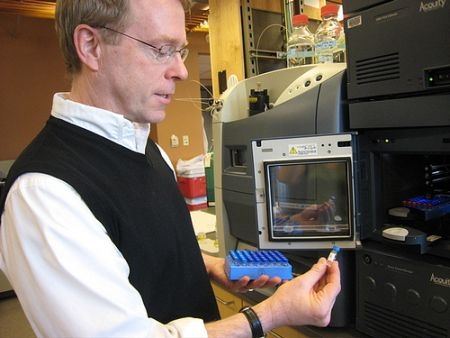
(Host) Researchers are studying rivers and ponds across the Northeast for traces of pharmaceuticals — not just from dumping, but from human waste.
This has raised concerns about whether they’re getting into drinking water.
As part of a collaboration with northeast public radio stations Nancy Cohen from WNPR reports.
(Cohen) Yale University Ecologist David Skelly is sitting next to a tranquil pond in suburban Connecticut. What he’s found below the surface is disturbing. In a study finished last year he looked at male frogs in a variety of places: near undeveloped forests, farm fields, urban and suburban neighborhoods.
(Skelly) "When we looked across that entire sample about 13% of all the male frogs had eggs in their testes."
(Cohen) None of these feminized frogs were found in undeveloped areas. The biggest percentage were found close to places where people live.
(Skelly) "When we went to suburbia and urban areas those numbers jump up to about 20%. So these urban suburban landscapes there’s something going on in wetlands that seems to drive these frequencies higher. So now we want to figure out what that is."
(Cohen) To do that Skelly is collecting pond water and hundreds of male frogs. He chose only ponds that have evidence of being tainted by human waste, like coffee.
(Skelly) "If there’s caffeine in a pond it came out of people. So that means there’s somehow wastewater getting into the pond. And caffeine is pretty broadly distributed in the ponds that we have sampled."
(Cohen) Skelly will test the pond water to see if it contains estrogen, a sex hormone that is naturally produced by female mammals, including humans. Birth control and prostate medicines contain a synthetic form. Skelly wants to know if estrogen is getting into suburban ponds from septic and sewer systems and causing the abnormalities in frogs.
This is a question the U.S. Environmental Protection Agency is interested in. Scientists there also want to know if pharmaceuticals are getting into drinking water.
(Rudzinski) "It’s an area that’s been of growing concern as we’ve begun to learn more and more about what might be present in our water."
(Cohen) The E.P.A.’s Suzanne Rudzinski says the agency is testing for pharmaceuticals at 150 sites on rivers across the country, including in the Connecticut, Hudson and Merrimac Rivers. But she says pharmaceuticals are difficult to detect at the very low concentrations that they’re found.
(Rudzinski) "Trying to find these part per trillion, part per quadrillion levels. That’s like trying to find an aspirin out of several Olympic sized swimming pools."
(Cohen) Despite the challenges pharmaceuticals, have been detected in drinking water. Although the EPA doesn’t require monitoring or treating for them, some water utilities are funding research to find out whether water treatment systems can remove pharmaceuticals.
University of Massachusetts Environmental Engineer David Reckhow has set up small scale water treatment systems that mimic a large scale water treatment plant.is investigating whether drinking water systems, including some in New Hampshire, Massachusetts and Rhode Island, are able to remove prescription drugs, including ones that contain estrogen.
(Reckhow) "To date what we’ve learned some of these pharmaceuticals and in particular the estrogenic compounds are easily removed by conventional water treatment."
(Cohen) Well, sort of. Reckhow goes on to say part of the estrogenic compounds remain after treatment.
(Reckhow) "We think there may be by products that are partly degraded, partly fragmented versions of the original estrogenic compounds. And they may still be biologically active."
(Cohen) Meaning these fragments could still affect people or animals. But Reckhow says no one knows yet what the effects are.
Suzanne Rudzinski of the E.P.A. says the agency is still investigating.
(Redzinski) "At this point we’re concerned, but we’re not alarmed. We think we still have one of the safest drinking water supplies in the world. And we think that the very low doses of pharmaceuticals that are showing up are probably not a major risk to human health, but again it’s a question we are still trying to get a better understanding of."
(Cohen) Just this fall the E.P.A. listed about a dozen pharmaceuticals, including some containing estrogen, on a list of contaminants that may be considered for regulation in the future.
For VPR News, I’m Nancy Cohen
(Host) Northeast environmental coverage is part of NPR’s Local News Initiative. The reporting is made possible, in part, by a grant from United Technologies.